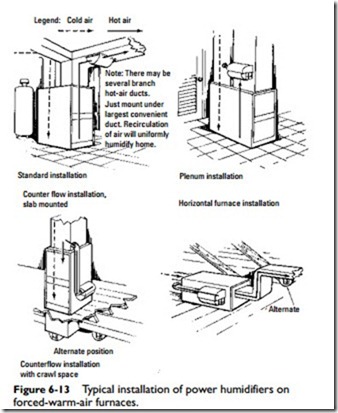Humidifiers and Dehumidifiers
Air that has a very low level of humidity is too dry for comfort and can cause damage to walls, interior woods, and furnishings. This results from the fact that dry air absorbs moisture from other sources, including the human body. The moisture-robbing effect of dry air is particularly noticeable on the sensitive nasal and throat membranes. Moisture can be added to the air by humidification, and the device used to add moisture is called a humidifier.
The humidifiers used in heating and cooling systems are designed to maintain the relative humidity within the comfort zone. They are available in a number of different types, each based on a different operating principle. Pan-type humidifiers, for example, contain a reservoir of water that evaporates into the warm air flowing through the supply duct. The water level in the reservoir is controlled by a float control. The desired humidity level is determined by a humidity control setting. When the relative humidity drops below the humidity control setting, a humidifier fan is actuated and air is blown over the water in the reservoir. Moisture is then picked up by the air and blown into the space to be humidified. Other types of humidifiers include (1) spray-type air washers and (2) steam-type humidifiers (either air or electrically operated). Typical humidifier installations are illustrated in Figure 6-13.
Sometimes air will have a humidity level that is too high. The excess moisture resulting from this condition can also cause dam- age to walls, interior woods, and furnishings as well as prove very uncomfortable for the occupants. Excess moisture can be removed from the air, and the device used to remove the moisture is called a dehumidifier.
Dehumidifiers operate either on the cooling or absorption method. The former method accomplishes dehumidification by an air washer with a water-spray temperature lower than the dew point of the air passing through the unit. Condensation occurs, and both latent and sensible heat are removed.
In the absorption method of dehumidification, sorbent materials are used for removing moisture from the air. Air to be dehumidified is drawn or blown through a screened bed of dry-solid absorbent, and the water vapor in the air is caught and retained in the pores of the absorbent.
Both humidifiers and dehumidifiers are described in greater detail in Chapter 11 of Volume 3.
